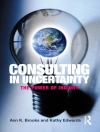The new quick reference for understanding anxiety disorders
The Wiley Concise Guides to Mental Health: Anxiety
Disorders uses clear, highly accessible language to
comprehensively guide the reader through the most frequently
diagnosed mental health problem-anxiety-and its related issues.
This concise, informative reference provides a complete history of
the field, conceptualization, assessment, diagnosis, treatment,
cutting-edge research, and other critical information.
Like all the books in the Wiley Concise Guides to Mental
Health Series, Anxiety Disorders features a compact,
easy-to-use format that includes:
* Vignettes and case illustrations
* A practical approach that emphasizes real-life treatment over
theory
* Resources for specific readers such as clinicians, students,
and patients
After discussing the conceptualization and assessment of anxiety
disorders, Anxiety Disorders covers treatment with sections on
client psychoeducation, cognitive tools, in vivo and imaginal
exposure, cognitive behavioral therapy (CBT) techniques, and
termination and relapse prevention. Additional issues covered
include other treatment approaches; working with children and
adolescents; working in group, family, and couples therapy
settings; supervision; and concerns and challenges for the
clinician. Useful to practitioners as an on-the-shelf resource and
to students as a complete overview, the Wiley Concise Guides to
Mental Health: Anxiety Disorders provides a complete and quick
reference for the diagnosis and treatment of anxiety disorders.
Tabla de materias
Series Preface.
Acknowledgments.
SECTION ONE: CONCEPTUALIZATION AND ASSESSMENT.
Chapter 1. Overview of the Anxiety Disorders.
Chapter 2. CBT for the Anxiety Disorders: Description and
Research Findings.
Chapter 3. Assessment of the Anxiety Disorders.
Chapter 4. Case Conceptualization and Treatment Planning.
SECTION TWO: Treatment of Anxiety Disorders.
Chapter 5. Client Psychoeducation.
Chapter 6. Cognitive Tools.
Chapter 7. In Vivo Exposure.
Chapter 8. Imaginal Exposure.
Chapter 9. Other CBT Techniques.
Chapter 10. Termination and Relapse Prevention.
SECTION THREE: ADDITIONAL ISSUES AND TREATMENT
CONSIDERATIONS.
Chapter 11. Additional Treatment Approaches.
Chapter 12. Treating Children and Adolescents with Anxiety
Disorders.
Chapter 13. Consultation and Collaboration with
Multidisciplinary Professionals.
Chapter 14. Group, Family, and Couples Therapy.
Chapter 15. Supervision.
Chapter 16. Clinician’s Top 10 Concerns and Challenges with
Treating Anxiety.
Appendix. Resources for Anxiety Treatment for Clinicians and
Self-Help for Patients.
Index.
Sobre el autor
Larina Kase, Psy D, is a licensed psychologist in private
practice in Plymouth Meeting, Pennsylvania, and President of the
international consultancy, www.PAScoaching.com. Dedicated to
disseminating information on overcoming anxiety, her work has been
seen in media like the New York Times and the Chicago Tribune.
Deborah Roth Ledley, Ph D, is Associate Director of the
Adult Anxiety Clinic of Temple University in Philadelphia and also
maintains a private practice in Plymouth Meeting, Pennsylvania. Her
publications include almost forty scientific articles and book
chapters on the nature and treatment of anxiety disorders.
Irving J. Weiner, Ph D, is the Series Editor for the Wiley
Concise Guides to Mental Health. He is a prolific author, and is
the editor of the award-winning 12-volume Handbook of Psychology,
also from Wiley.












